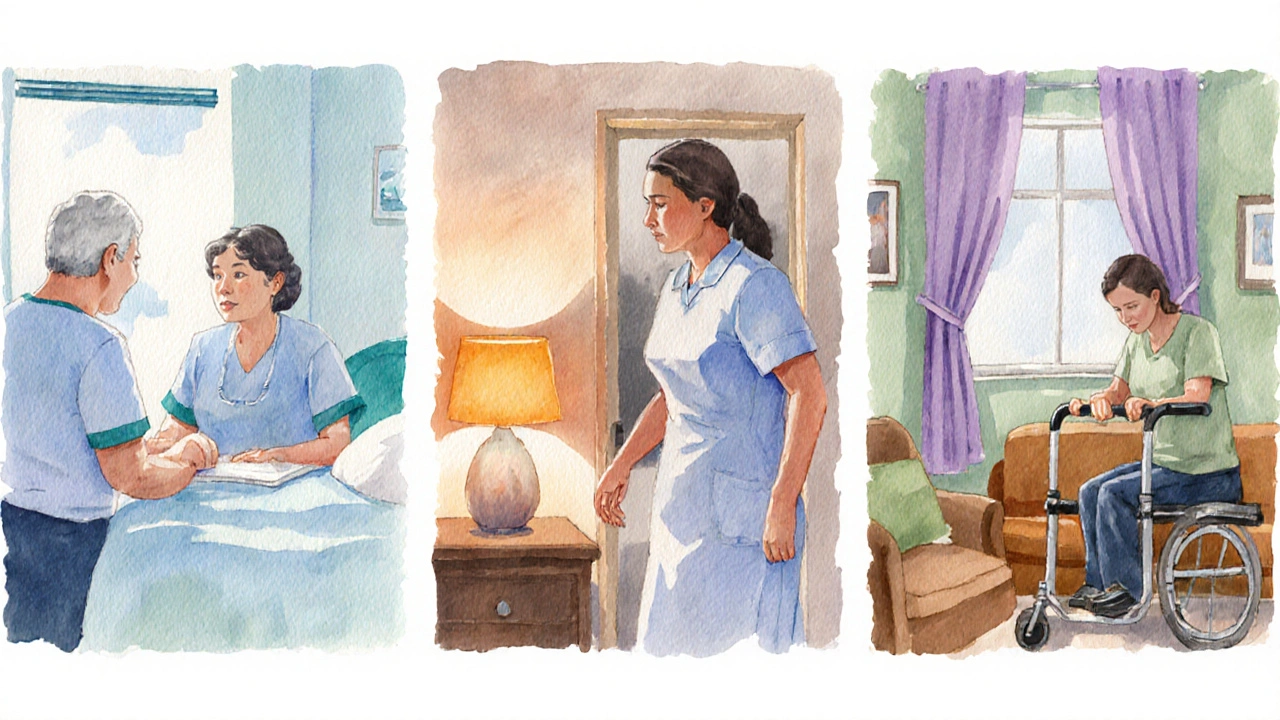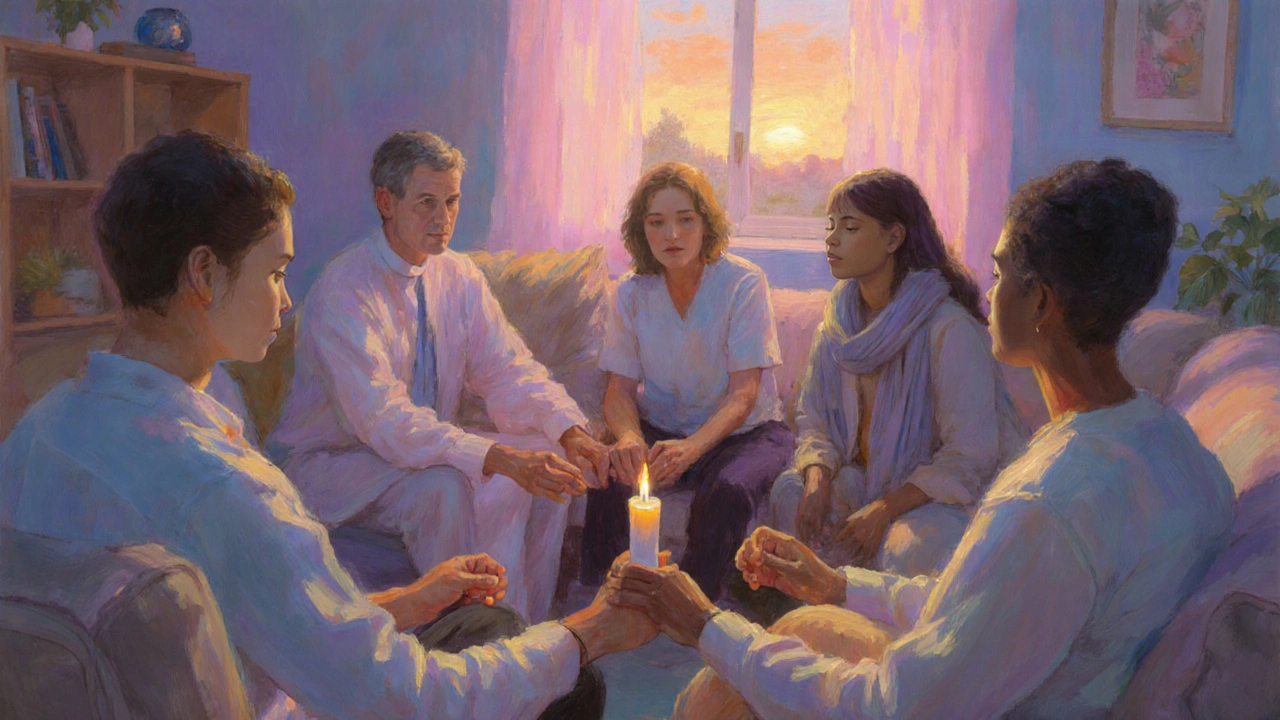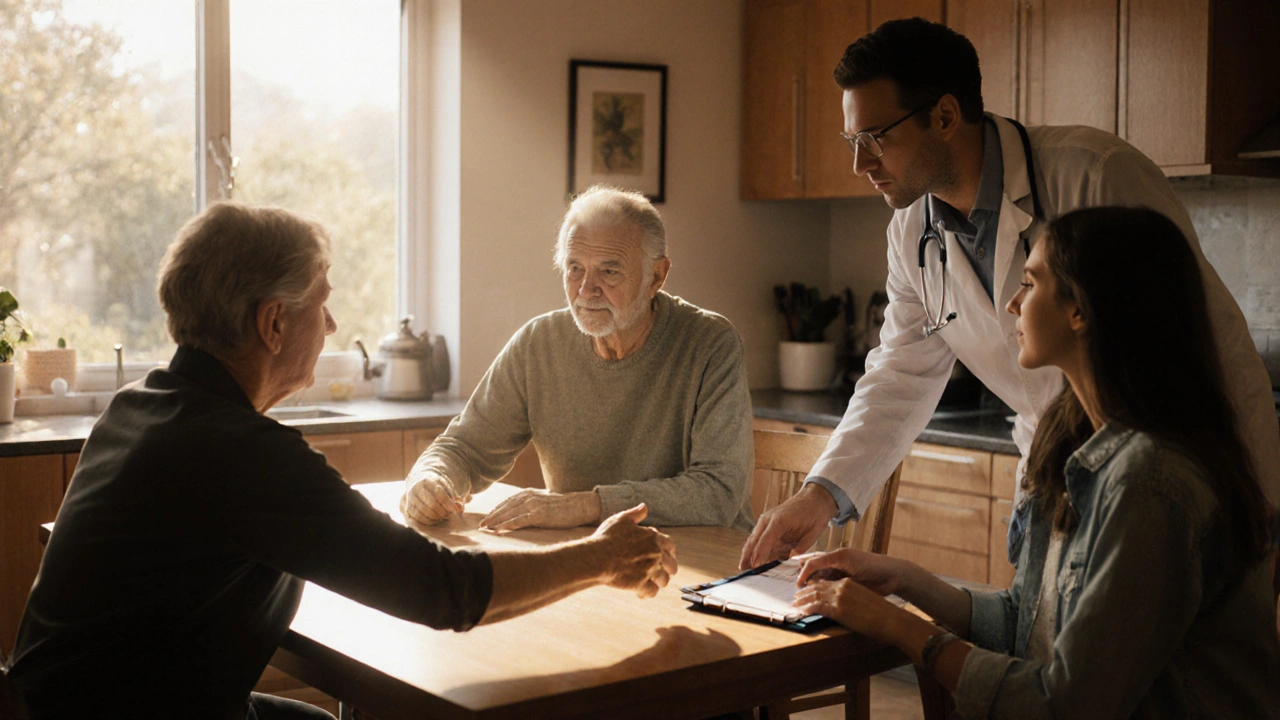Myeloma End-of-Life Care Decision Helper
Palliative Care
Focuses on symptom relief while continuing disease-modifying therapy. Often provided alongside active treatment.
- Manages pain and fatigue
- Provides psychosocial support
- Works with oncology team
Hospice Care
Provides comfort-focused care when life expectancy is estimated at 6 months or less.
- 24/7 nursing support
- Spiritual care included
- Includes bereavement services
Home-Based Care
Maintains independence in a familiar setting with visiting professionals.
- Visiting nurses
- Physiotherapy
- Family caregiver training
Advanced Care Planning
Documenting your wishes for medical treatment and decision-making.
- Designate healthcare proxy
- Specify treatment preferences
- Address cultural/spiritual needs
Symptom Management Tips
- Bone Pain: Use bisphosphonates, gentle exercise, and heat therapy
- Fatigue: Manage anemia, stay active, practice good sleep habits
- Neuropathy: Adjust medications, use gabapentin or duloxetine
- Infection Risk: Stay up-to-date on vaccines, practice hygiene
Quick Action Checklist
Need More Help?
Reach out to:
- Your oncologist or palliative care team
- Local myeloma support groups
- National helplines like Cancer Research UK
- Professional chaplains or spiritual counselors
Remember: Taking these steps early helps you shape your journey rather than react to it.
Facing a myeloma diagnosis is tough, and the conversation often shifts to how to keep quality of life as the disease progresses. Families and patients wonder what steps they can take now to make the later months as comfortable and meaningful as possible. This guide walks you through the essential pieces of end-of-life care, from understanding the disease to creating a solid care plan, managing pain, and tapping into the right support resources.
Key Takeaways
- Early conversations about goals of care prevent rushed decisions later.
- Palliative care focuses on symptom relief, while hospice adds a team‑based, home‑or‑facility approach for those with a limited prognosis.
- Documenting wishes in an advanced care plan ensures your voice is heard across all care settings.
- Effective symptom management-especially bone pain and fatigue-greatly improves daily quality of life.
- Local and national support networks can reduce emotional strain for patients and caregivers.
Understanding Myeloma is a type of blood cancer that originates in plasma cells, the antibody‑producing cells in bone marrow. It causes bone damage, anemia, kidney issues, and immune suppression. According to the International Myeloma Working Group, about 35,000 new cases are diagnosed in the U.S. each year, and the median survival has risen to around 7‑10 years thanks to newer therapies.
Even with treatment advances, many patients eventually enter a phase where the focus shifts from curing the disease to living well with it. That’s where end-of-life planning becomes crucial.
What Is End‑of‑Life Care a coordinated set of services designed to support comfort, dignity, and personal goals during the final stage of a serious illness?
End‑of‑life care isn’t just about the last weeks; it begins as soon as a serious, life‑limiting diagnosis like myeloma is made. The core aim is to control symptoms, respect patient preferences, and ease the emotional load on families.

Building an Advanced Care Plan
An advanced care plan (ACP) is a written record of your wishes concerning medical treatment, location of care, and who should make decisions if you’re unable to speak for yourself. Here’s a quick checklist:
- Identify a health‑care proxy-someone you trust to interpret your wishes.
- Specify preferred interventions (e.g., do‑not‑resuscitate, intubation preferences).
- Choose a care setting: home, hospice facility, or hospital.
- Document religious or cultural considerations.
- Review and update the plan annually or after any major health change.
Make sure the ACP is shared with your oncologist, primary care doctor, and any palliative‑care team members.
Choosing the Right Support Model
Three main models often appear for patients with advanced myeloma:
| Model | Primary Goal | Typical Length of Stay | Key Services |
|---|---|---|---|
| Palliative Care | Symptom relief while disease‑modifying therapy continues | Any duration, often concurrent with active treatment | Pain management, psychosocial support, diet counseling |
| Hospice | Comfort‑focused care when life expectancy ≤6 months | Usually 30‑180 days, based on eligibility | 24/7 nursing, spiritual care, bereavement services |
| Home‑Based Care | Maintain independence in a familiar setting | Flexible, from weeks to months | Visiting nurses, physiotherapy, caregiver training |
Choosing a model depends on prognosis, personal values, and the support network you have at home.
Managing Common Symptoms in Myeloma
Myeloma patients often grapple with bone pain, fatigue, neuropathy, and infection risk. Here’s how to tackle each:
- Bone Pain: Bisphosphonates (e.g., zoledronic acid) reduce skeletal events. Pair medication with gentle physiotherapy and heat packs.
- Fatigue: Optimize anemia with erythropoietin‑stimulating agents if indicated, maintain activity levels, and prioritize sleep hygiene.
- Neuropathy: Adjust dose of neurotoxic drugs, use gabapentin or duloxetine, and protect limbs from injury.
- Infection Risk: Keep vaccinations up‑to‑date, employ prophylactic antivirals for herpes‑zoster, and educate caregivers on hand hygiene.
Regular check‑ins with a palliative‑care specialist ensure that medication regimens stay balanced-enough relief without excessive sedation.

Support Resources and Emotional Care
Emotional and practical support is a cornerstone of end‑of‑life care. Resources include:
- Clinical Trials: Even late‑stage studies may offer access to novel agents that improve symptom control.
- Local support groups (often run by the Myeloma Canada or UK Myeloma Trust) provide peer insights and a safe space to share fears.
- National helplines such as Cancer Research UK’s 24‑hour advice line deliver counseling and navigation help.
- Spiritual care services-chaplains, faith‑based counselors-address existential concerns.
Ask your healthcare team to make introductions; many services are free or covered by the NHS.
Next Steps for Patients and Caregivers
- Schedule a dedicated conversation with your oncologist about prognosis and timing of palliative‑care referral.
- Draft or update an advanced care plan using the checklist above.
- Identify the preferred care model (palliative, hospice, home) and discuss eligibility criteria.
- Implement a symptom‑tracking journal to share with your care team during visits.
- Connect with at least one support resource-whether a local group or a clinical‑trial coordinator.
Taking these steps early empowers you to shape the journey rather than react to it.
Frequently Asked Questions
When should I consider hospice for my myeloma?
Hospice becomes appropriate when life expectancy is estimated at six months or less and the focus shifts entirely to comfort. A palliative‑care physician or oncologist can help assess eligibility based on disease trajectory and functional status.
Can I still receive chemotherapy while in palliative care?
Yes. Palliative care often runs parallel with disease‑directed therapy. The goal is to balance treatment benefits with side‑effects, ensuring quality of life remains paramount.
What does a ‘do‑not‑resuscitate’ (DNR) order entail?
A DNR order tells medical staff not to perform cardiopulmonary resuscitation if your heart stops. It does not affect other treatments like pain medication, antibiotics, or comfort measures.
How can I manage bone pain without heavy opioid use?
Strong pain relievers are often needed, but adjuncts such as bisphosphonates, low‑dose corticosteroids, nerve blocks, and non‑pharmacologic methods (heat, TENS units, gentle stretching) can lower opioid dosages.
Is it possible to continue living at home while on hospice?
Absolutely. Most hospice programs offer in‑home services, providing nurses, aides, and equipment to keep patients safe and comfortable at home.

Tara Phillips
October 10, 2025 AT 16:26Dear members of this community, I wish to acknowledge the thoroughness of this Myeloma End‑of‑Life Care Guide; its structure, from symptom management to advanced care planning, reflects an admirable commitment to patient welfare. The inclusion of actionable checklists and resource links provides a pragmatic framework that can empower both patients and caregivers. Moreover, the emphasis on early conversations aligns with best‑practice standards in palliative medicine. May this resource serve as a beacon of hope and preparation for those navigating this challenging journey.
Derrick Blount
October 13, 2025 AT 17:51Indeed, the guide represents a confluence of clinical rigor and compassionate foresight; however, one must contemplate the ontological implications of “preparing” for mortality-does planning diminish the existential weight, or does it merely redistribute it across a spectrum of defined choices? Moreover, the stratification of care models, while methodical, could benefit from a probabilistic assessment of prognosis, thereby attenuating the binary perception of hospice versus active treatment. Nevertheless, the educational merit remains indisputable; the guide functions as both a compass and a repository of evidence‑based interventions.
Anna Graf
October 16, 2025 AT 19:15It’s clear that talking about the future helps people feel less scared. The guide shows simple steps that can be followed. Even the small tips, like using heat for bone pain, can make a big difference. When families work together, they can keep the patient’s wishes front and center.
Jarrod Benson
October 19, 2025 AT 20:39Wow, where do I even start after reading this massive piece of brilliance that practically reads like a road‑map for the hardest part of a cancer journey, and I have to say that the energy poured into each section feels like a rallying cry for anyone who’s ever stared at a lab report and thought, “What now?” First off, the way the guide breaks down pain management, from bisphosphonates to heat therapy, reads like a cheat sheet you wish you’d had the moment the first twinge hit your ribs; second, the checklist approach gives you that satisfying tick‑box feeling that keeps you from drowning in overwhelm, and third, the emphasis on early conversations with the oncologist actually reminds us that procrastination is a luxury we can’t afford when life is on the line. I love how the section on home‑based care doesn’t just throw jargon at you but actually lists visiting nurses, physiotherapy, and caregiver training, which basically tells families, “Hey, you’re not alone, we’ve got a team ready to roll.” The part about advanced care planning is a masterclass in making your voice heard, especially when it tells you to designate a health‑care proxy and revisit the plan every year, because let’s face it, life changes faster than a treatment protocol. Then there’s the whole discussion on hospice care, which for many feels like admitting defeat, but the guide flips the script and shows hospice as a comfort‑focused cushion, not a sign of “giving up.” I also appreciate the practical tips-like staying up‑to‑date on vaccines-to keep infections at bay, because nobody wants another hospital stay when you’re already juggling chemo. The resource list at the end, with helplines and support groups, is the digital equivalent of a warm hug, reminding you that there’s a community out there who gets it. While the language is mostly straightforward, the occasional use of terms like “palliative‑care physician” subtly nudges you toward professional help without sounding preachy. The visual tables comparing care models are a great example of data presented in a way that even a non‑medical person can digest, which is crucial when decisions are made under stress. Reading about symptom tracking journals made me think about how a simple spreadsheet could become a lifeline during tough days, providing doctors with clear data to adjust treatment. The guide also wisely points out that clinical trials may still be an option, keeping the door open for innovative therapies even in later stages. All in all, the guide feels like a friend sitting beside you, handing you a flashlight in a dark hallway, and I can’t stress enough how valuable that is. So, to anyone reading, grab this guide, share it with your loved ones, and let’s make this journey a little less lonely, a little more informed, and a whole lot more hopeful.
darren coen
October 22, 2025 AT 22:03I hear you, and I’m sending strength.
Jennifer Boyd
October 25, 2025 AT 23:27Friends, let’s celebrate how this guide turns a daunting topic into a tapestry of hope and action; the dramatic flair of listing hospice benefits alongside lively home‑care options really lifts the spirit! I love that the guide doesn’t just dwell on sorrow but paints vivid pictures of comfort, support, and shared moments. Keep shining that friendly light, because every patient and caregiver deserves a burst of optimism in the midst of uncertainty.
Lauren DiSabato
October 28, 2025 AT 23:51While the prose attempts to be uplifting, it ultimately sacrifices clinical precision for sentimental fluff, which may mislead readers into underestimating the gravity of end‑of‑life decisions. A more rigorous analysis, rather than poetic platitudes, would better serve an audience seeking substantive guidance.
Hutchins Harbin
November 1, 2025 AT 01:15Let’s cut through the pretentiousness: the guide’s strength lies precisely in its ability to blend heartfelt language with evidence‑based recommendations, and dismissing emotional resonance ignores the holistic nature of patient care. Moreover, the factual sections are meticulously sourced, so the “fluff” you decry actually enhances comprehension.
Benjamin Herod
November 4, 2025 AT 02:39In a formal analysis, the guide indeed integrates narrative with data, yet the dramatic interludes occasionally eclipse the stark realities of disease progression. A balanced tone, neither overly solemn nor overly lyrical, would optimize both readability and gravitas. Nonetheless, the document remains a valuable compendium for those confronting advanced myeloma.
luemba leonardo brás kali
November 7, 2025 AT 04:04The guide’s structure adheres to a logical progression, commencing with symptom management and culminating in advanced care planning, thereby facilitating user navigation. Each subsection incorporates precise terminology and conforms to standard medical guidelines, which enhances its credibility. Overall, it serves as a well‑organized reference for both patients and clinicians.
Corey McGhie
November 10, 2025 AT 05:28Oh great, another textbook‑style rundown-because what we really need is more clinical jargon, right? In all seriousness, though, the clear headings do help, but a sprinkle of relatable anecdotes would make it far less sterile. Just saying, a dash of humanity never hurt anyone.
Sadie Bell
November 13, 2025 AT 06:52Hey everyone, this guide is a solid starting point and I’m hopeful it’ll help many people get through tough times.
Noah Bentley
November 16, 2025 AT 08:16Sure, “solid” is the word, but let’s not sugarcoat the fact that navigating hospice paperwork can feel like wading through mud-no one wants that. Maybe a blunt checklist of the bureaucratic hoops would spare families some unnecessary heartache.
Kathryn Jabek
November 19, 2025 AT 09:40Esteemed colleagues, the guide’s eloquent articulation of advanced care planning, replete with vivid lexicon, exemplifies a commendable synthesis of clinical acumen and literary flair; however, its occasional verbosity may obscure actionable directives, demanding a more concise presentation for optimal efficacy.
Ogah John
November 22, 2025 AT 11:04Ah, the classic clash of style versus substance-while flamboyant prose can inspire, it should never eclipse the clarity required for life‑critical decisions. A thoughtful balance, perhaps, would honor both the mind and the heart of the reader.
Christian Andrabado
November 25, 2025 AT 12:28Reading this feels like a breath of fresh air, the info is clear and the tone is just right for anyone dealing with tough choices.
Jennifer Banash
November 28, 2025 AT 13:52Indeed, the guide achieves an elegant equilibrium, delivering vital facts with a poised gravitas that commands respect and instills confidence in its readership.
Stephen Gachie
December 1, 2025 AT 15:16The document, while philosophically inclined, could benefit from a tighter narrative flow; nonetheless, its comprehensive scope offers a valuable foundation for patients navigating end‑of‑life care decisions.